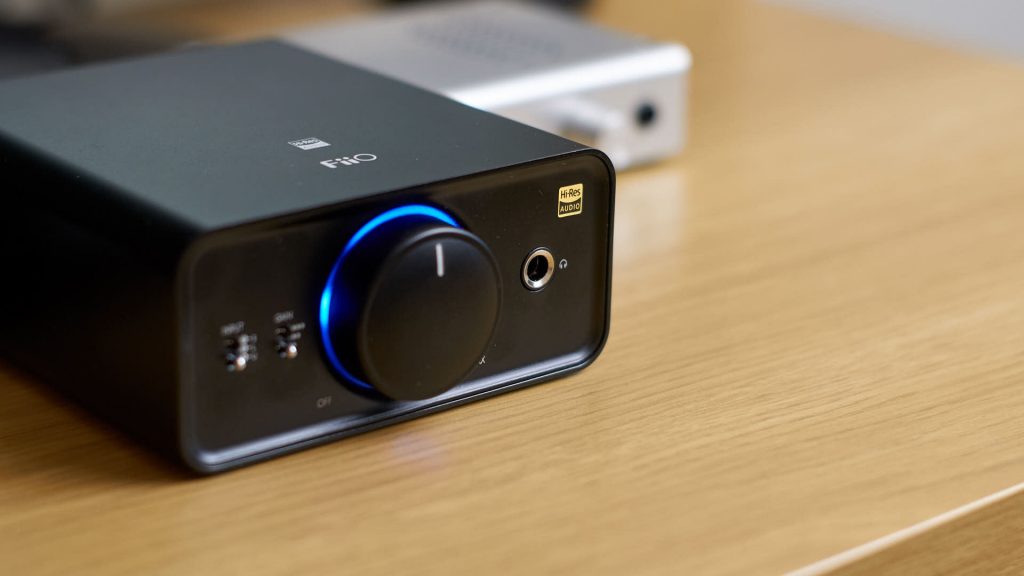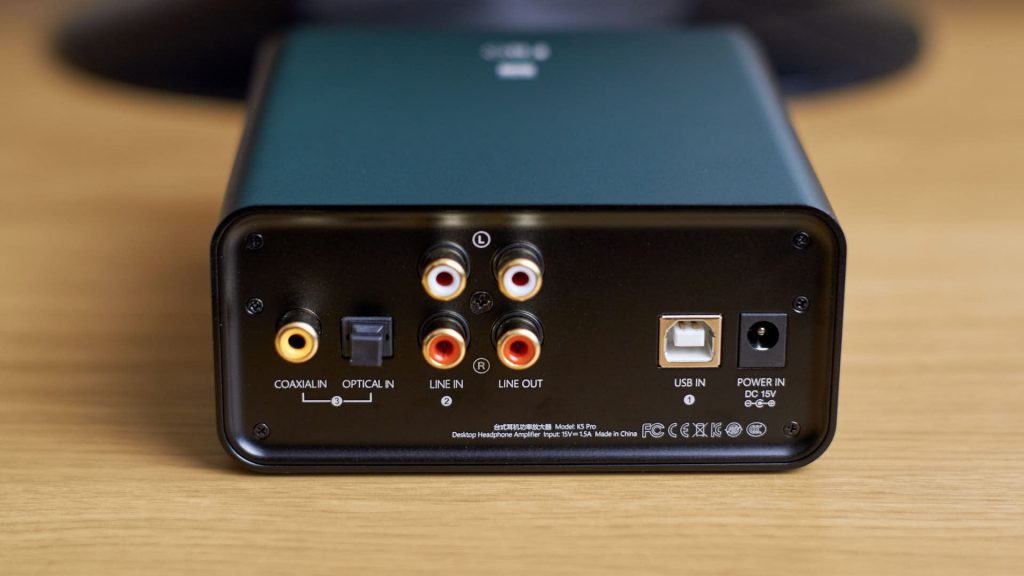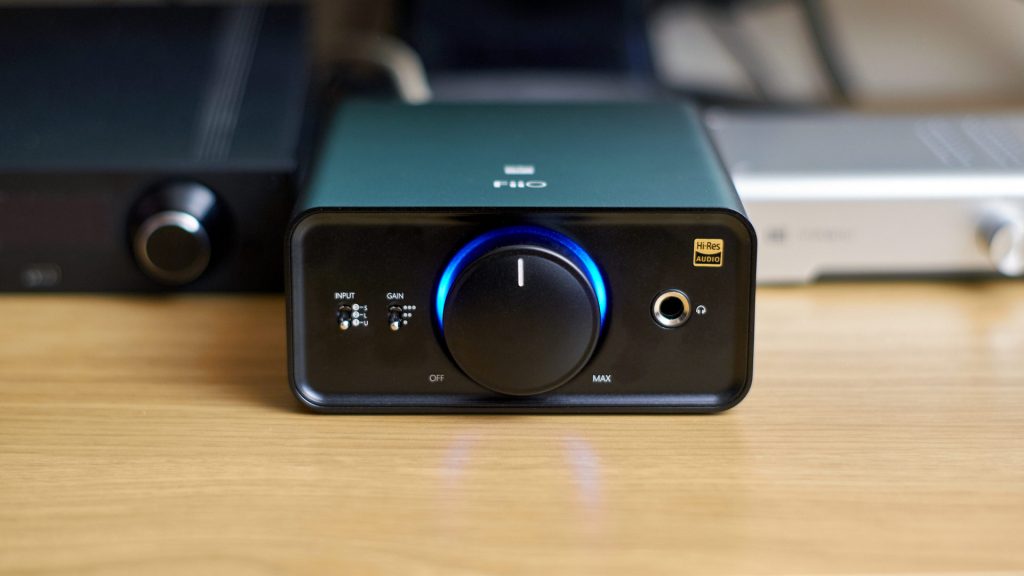I’ve been getting requests to review Fiio K5 pro for quite some time now. It wasn’t easy to find it due to the stock shortages, but I finally managed to get one so here we are.
Fiio K5 pro sure looks promising on paper with the latest Asahi Kasei AK 4493 DAC chip being the heart of the device. XMOS USB interface is making sure to provide you with all of the format support you’ll ever need. It supports PCM up to 32 bit / 768 kHz, and DSD up to DSD512. Texas Instruments TPA6120 amplifier is used to provide up to 1.5 W over the headphone out.

BUILD AND FEATURES
Aluminum box with rounded edges gives K5 pro a clean look. On the back, we have a usual set of digital connections: USB, coaxial and optical. A pair of RCA connectors provide a variable line-out. It is controlled by the volume knob and there is no direct/fixed level mode. Another RCA pair is Line-in if you wish to connect external DAC to the unit.
On the front, we find an input selector, gain selector, and 6.35 mm headphone out. The big volume knob in the middle doubles as a power switch too. It feels smooth and nice to use. When the unit is turned on, a ring around the volume knob lights with different colors depending on the signal and format being played.
As you can see, it’s a pretty versatile unit that can be used as a DAC/AMP combo, but each of the sections can be used separately with external devices too. In terms of functionality, everything worked as expected and without a fuss. So let’s get to the most important part.

SOUND (DAC/AMP TOGETHER)
With Takstar Pro 82
I started the test with a less demanding but analytical Takstar Pro 82. Low gain mode proved more than sufficient to drive them with ease. More than that, the sound coming from them was very neutral. Bass goes deep but isn’t overblown in any way. Vocals and all instruments sounded clear and clean. They are not boldened by excessive mid-bass or sharpened by pronouncing upper registers. Simply put, the sound was as good as I ever heard Pro 82 sound. Going to the mid gain setting added a bit of warmth to the midrange, but at the expense of some transparency. Anyway, it sounded very pleasant with these analytically inclined Takstars.
With Hifiman HE-4XX
Next, I switched to Hifiman HE-4XX. Despite their low impedance of 34 Ohms, these planars like to be powered with a good source to show their best. I started with a low gain mode again and I needed to turn the volume generously to put a proper volume. But what I got in return was again a very neutral and transparent sound with just a hint of warmth in the bass region.
Listening to Allan Taylor – Behind the Mix, both vocals and guitars sounded crisp and clean. Strings and transients had enough bite and energy. Moving to something more upbeat such as Daft Punk – Random Access Memories showed another set of skills. Deep bass notes kikced with real intent and focus you simply don’t hear that often in this price range. Going above the bass line, everything sounded organized and well layered, making listening to these busy songs a pleasure. Plenty of details are presented in a way that never feels forced or too tacky. Browsing trough even more music genres I found that K5 pro is not selective. Its well balanced and neutral approach made it a true all-rounder.

Gain levels
One more time, mid-gain setting proved to add some warmth into midrange and vocals compared to low gain. Everything sounds a bit juicier but also a bit less transparent and less airy. This is surely a matter of taste, but I prefer to stay in a low gain mode as long as I have enough volume. I never really had to revert to a high gain mode. When engaged, transparency takes another small hit so I stuck with two lower levels. I believe that high gain should be used only with the most demanding headphones that wouldn’t get enough juice otherwise.
To finish this part, I tried it with several other headphones I had at hand, including a few IEMs. K5 pro worked well with all of them.
SOUND – LINE OUT
As I already mentioned in the beginning, using a direct (fixed level) line out is not really possible. The signal always goes trough volume control so K5 pro acts like a passive pre-amp. Nevertheless, maxing out the volume will give you 2 V at RCA outputs, which is the common level of most modern DACs.
Hooked to Schiit Magni 3 or my main room setup, RCA out didn’t disappoint. As it is the case with a headphone out, the sound signature is well balanced. However, detail retrieval and layering are not at the same level as some of the best DACs at this price range. That said, line out is still quite capable. For example, it resolves more details and offers wider soundstage than Dragonfly Black. That should be more than sufficient for a decent pair of desktop speakers or an entry-level hifi system.
COMPARISONS
I had at hand a few DACs and AMPs so I took a chance to compare K5 pro with them.
Let’s start with the cheapest. Dragonfly Black and Lusya Fever are both clearly outgunned here. K5 pro offers more details, deeper and better-controlled bass, better separation and layering. It might not be that obvious with less demanding and resolving headphones, but it is with better ones.
Schiit Modi 3 & Magni 3 is a very capable combo. I found it a bit more exciting while listening to performers such as Allan Taylor, Sara K., etc. Their prominent vocals and guitars sounded just a touch more energetic and exciting. Moving to some faster, busier, and bass-havier tracks K5 pro punched back. Daft Punk, Tool, Massive Attack, etc. showed how skillful K5 pro really is with deep bass notes. It goes low, it kicks hard, it never loses control. And when things get busy with a plethora of instruments and sounds mixed together, K5 pro stays more composed too.
Burson Playmate comes at more than twice the price. It offers firmer bass notes (less warm), a bit longer tone decay, and recreates more of the track’s atmosphere. But the trick is, the jump is not as huge as you might expect. Going back to K5 pro, I quickly forget about those subtle differences and simply start enjoying the music. On the other hand, Playmate has a superior line-out section that is heads and shoulders above K5 pro.

I’d like to have iFi Zen DAC with me but I don’t anymore. That’s why I’ll dig into my memory here and you should take this part with a pinch of salt. I believe that K5 pro is clearly a more capable device when it comes to headphones. It has more power, focus, and control over bass notes. But I do feel that Zen would win used as a DAC only over its line out section. I remember it offering greater transparency and detail retrieval.
CONCLUSION
Fiio K5 pro is a very versatile device. It can be used as a DAC only or AMP only, but where it really shines is when it’s used as a whole. If headphones are your primary way of listening to music, it’s easy to fall in love with K5 pro. It has a great set of features, it’s fuss-free to use and most importantly it sounds great, offering both subtlety and power. It’s one of those devices – the more I use it the more I grow attached to it.
Of course, the recommendation is in order. Just be sure to pair it with a capable set of cans and K5 pro will show you its skills in return.
| FIIO K5 PRO – CHARACTERISTICS |
|
DAC: AK4493 Price at the time of review: $159 (US/China) / 189€ (EU) |
| FIIO K5 PRO – CHARACTERISTICS |
|
DAC: AK4493 Price at the time of review: $159 (US/China) / 189€ (EU) |






Can I use the K5 Pro with an Apple IPad Air 2, and if so what would
a Grado SR325E cans sound like through it.
I also would like to know if I could connect the K5 to a rather old
Opus 21 CD player between the CDs box and a Cambridge AV Amp
to improve the sound quality. I have been told that this player cannot
be improved upon, as the Dac is connected to the Transport via an
Umbilical lead.
Your reply to this problem, would be greatly appreciated.
Kind regards,
David.
Great job!!!
Is there a possibility for you to review the new ESS version of this?
Thanks!